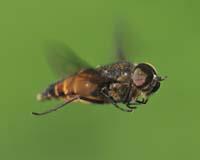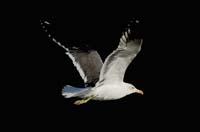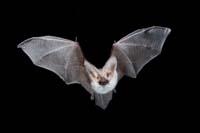Flight: paradigm of evolutionary leaps

Evolution is not force but process.
Evolution is not cause but law.
John Morley (1838-1923). English politician and journalist.
In the evolution of life, several groups of animals have managed to fly actively. Insects first, pterosaurs, then birds and finally bats, separately, have managed to lift the feet of the earth and look at the world from another perspective, that is, add to their lives a third unknown dimension.
Few evolutionary leaps have had as much influence as the ability to fly, which represents a dizzying change in the evolution of a lineage. This new capacity incorporates the lock key of numerous doors and allows animals to access new ecological corridors until then unknown. There is nothing more to see the evolutionary success of flying animals: 1,100 species of bats (20% of mammals), 10,000 species of birds (55% of sauropsides) and 950,000 species of insects (81% of arthropods) are known.
This is a topic that has long been discussed on how and why the ability to fly developed and has always been one of the most exciting debates on evolution. Flight is the paradigm of evolutionary achievements, the achievement that lays the foundations of a new evolutionary lineage, before which it is worth letting the imagination fly. Let's go back and start the journey on flight evolution, evolution hypotheses and flight models.
Fly, why, for what?

The man's dream of flying is always reflected in the legend of Ikaro and Daedalus. However, the legend of Icarus rarely coincides with the evolution of flight capacity. One main reason is that of radically differentiating both histories --mythological and natural-: the wings built by father and son with the aim of fleeing Crete, while evolution has created them without any objective or destiny.
Looking for things in evolution is useless work, because evolution has no capacity to look to the future. Evolution affects certain times and places; natural selection - the main motor of evolution - prefers the specimens best adapted to certain moments and places. Those who are able to survive in certain conditions and have more descendants are those who write evolutionary history.
The theory of evolution was presented by Charles Darwin and Alfred Wallace in 1858. The new ideas of the two naturalists were as uncomfortable as a drop of oil poured into a container with water between the gremioids of the time. Ideas were absolutely revolutionary and, although accepted by several, many found it difficult to set aside a static and orderly mindset and take on a constantly changing world view.
One of the fighters of Darwin's ideas was the British naturalist George Mivart. According to Mivart, although natural selection could explain the abundance or conservation of species, it could not clarify how new species or characteristics appeared. Mivart, like many others, could not understand what advantages could offer an animal a quarter of an eye, a half tail or a few tiny wings.
Darwin had to face this dilemma and, from then on, found an interesting answer that would become the milestone of the orthodoxy of evolution: the need to rule out the concept of functional continuity. That is, characteristics do not have to fulfill the same function in all generations. Is a bird capable of flying with 10% of wings? No, of course. But who says those ten wings had a function of flying from the beginning?
XIX. This concept gained strength at the end of the 20th century. It was called pre-adaptation, but due to the finalist connotation that may have its name, paleontologists Stephen Jay Gould and Elisabeth Vrba created the concept of exaptation in the early 1980s. The phenomenon called exaptation consists in giving a new use to a characteristic adapted by natural selection for a given function. Today it is difficult to understand the evolution of flight capacity without the contribution of Darwin, Gould and Vrba.
Evolutionary hypothesis

All theories of the ability to fly are based on exaptation, that is, protons, instead of being to fly, were initially used for something different. It is not clear what wings were used for before flying. Several hypotheses have been raised since there is no single hypothesis that serves to explain the evolution of all animal groups.
Predator hypothesis
The wings would develop for the capture of small prey, according to this hypothesis. The larger the wings, the more food the animal would have.
Glider hypothesis
According to this hypothesis, flying animals came from the gliding ancestors. In fact, the longer and wider the wings, the greater the planning capacity. Currently there are reptiles and mammals that do not fly actively but are able to carry out long planning flights, such as lizards and collugas of the genus Draco.
Cursor hypothesis
According to this hypothesis, the wings only served to help maintain balance during the race and to give longer jumps. Small wings improve race efficiency, as demonstrated in a study with chites of different species. Fry would be, among other things, beneficial characteristics for hunting or flight.

Southern models
All flying animals share one characteristic: being wings. The wings of the insects come from appendages of the outer skeleton, which differ markedly from the rest. However, the wings of pterosaurs, birds and bats have greater similarities with each other. However, they are not homologous elements, that is, they do not have the same origin. The three south-southern models have similarities due to limitations imposed by phylogeny (such as the bones that form the arm) and the biomechanics of flight (physical bases for flight), but it is evident that each has followed their path, since different functional models have emerged.
Pterosaurs Model
Pterosaurs were the first vertebrates to achieve the ability to fly and the largest flying animals on Earth. The kings of the air remained for more than 140 million years, until 65 million years ago they disappeared along with most dinosaurs (except birds). It is believed that the flight model of the pterosaurs arose from a corridor of arcoaurs, since no planning ancestors of the pterosaurs are known.
Model of birds
The group of birds has had the greatest success among flying vertebrates. As already mentioned, several studies have revealed that some young birds that do not have fully formed wings use wings to run. In addition, fossils have shown that birds are descendants of bipedal dinosaurs. Therefore, wings, before being valid structures for flying, may be auxiliary structures for running. On the other hand, it seems that their formation is related to the ability to regulate the internal body temperature, so they are another example of the exaptation.
Bat model

Bats are the latest group of animals to fly. The debate on the evolution of bat flying capacity is still alive. Although historically believed to have emerged from gliding animals, there are currently scientists who argue that active flight was achieved by other means. These have used information based on the use of tail and embryogenesis to defend their hypotheses.
Reasons for the study of evolution
The essence of all this is not limited to the origin and morphology of the wings. The fact that bats have 600 pulses per minute or that the colibries shake the wings 50 times per second is not the result of the mere evolution of the wings. The agitation of the wings supposes a huge energy expenditure and the adjustment of anatomy and body physiology to this expenditure has been the most spectacular achievement developed by flying animals. While a specific characteristic --the development of wings, for example- can cause the beginning of a new evolutionary pathway, it is necessary that thousands of changes and adaptations occur to develop an efficient and evolutionarily stable characteristic such as flight.
Evolution, preadaptation, exaptation... The study of flight development has many consequences. Many things have been found in recent decades and many theories and models have emerged in human imagination. Although the analysis of evolution is a retrospective abstract exercise, knowledge and experimentation based on current models is the way to understand this exciting journey. And the present can offer us more information than expected about the future and the future.
Is there more mental exercise than studying and inferring the functioning of our environment?






